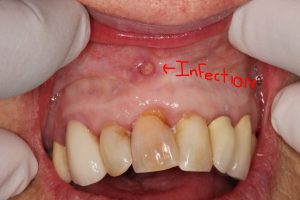What are Mini Dental Implants?
Over the past several years I have had many patients present to our office asking about Mini Dental Implants. They are interested in them mainly because they are significantly less expensive than a Regular Dental Implant. Lets look at the differences between a Regular Dental Implant and a Mini Dental Implant, and you will be able to determine the Pros and Cons of each, which will help you determine which one is best for your particular condition.
Also, try to think about a Dental Implant as an Artificial Root, which replaces the tooth root that was originally in the jawbone. The Artificial Root=Dental Implant, is secured into the jawbone, then a crown, bridge, or denture is secured on top of this artificial root.
Regular Dental Implants = Replacement Artificial Roots
1) Used to replace one tooth, multiple teeth, or all the teeth in one or both jaws.
2) The most important factor regarding the strength of the Implant in the Jawbone is how wide the Implant is. Therefore it is recommended that Dental Implants be at least 3.5 mm wide if replacing the front teeth, and at least 4-6 mm wide for replacing a back tooth/teeth.
3) Used in areas of the Jawbone where their is enough bone.
4) If their is not enough bone to allow the right size Implant to be inserted, then the bone needs to be corrected so that the right size Implant can be placed.
5) If the bone is insufficient, it is not recommended to use a narrower/shorter Implant.
Mini Dental Implants = Metal Anchors in the Jawbone
1) Used to provide increased Stability and Function of a Full Denture.
2) Used to support a Temporary Bridge
3) Most Mini Dental Implants are 1.5 mms wide.
4) Mini Dental Implants, due to their narrow diameter, are much more likely to fracture and come loose inside the bone due to their lack of rigidity and lack of fusing with the jawbone. Therefore they are not a long term solution.
In Conclusion, Mini Dental Implants are an inexpensive, quick way to help achieve a better functioning Denture. If their is enough bone, or enough bone can be re-built, a standard size Dental Implant provides a much better foundation on which to anchor a Full Denture. In my practice, Mini Dental Implants are used solely as a temporary anchor for the Denture, while the more rigid, permanent Implants are healing under the gum. If you are going to get Mini Dental Implants and are expecting them to last forever, I would expect them to last about 1-3 years at best and I would recommend having the Regular Size Dental Implants Inserted. Please ask your Dental Provider about the above information so that your expectations can be met regarding having Mini Dental Implants inserted.
Thank You
Robert Taylor DDS FICOI











